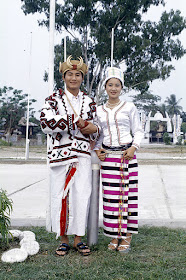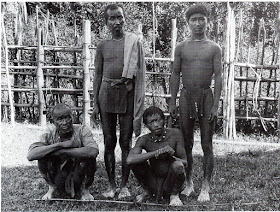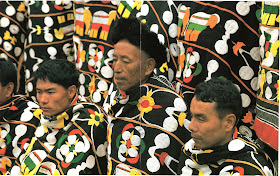Hello all,
This is the third installment of my overview of the Peoples of Myanmar. Today I will focus on the peoples of the north and west.
Kachin
https://en.wikipedia.org/wiki/Kachin_State
Kachin State lies in the northeast of Burma, bordering Yunnan on the east, Tibet to the north, India [Arunachal Pradesh] and Sagaing region to the west. The term is also used loosely as a catch-all to refer to any of the various peoples that inhabit this area. Besides the Hkamti Tai Shan, there are several peoples in the area who represent three branches of the Sino-Tibetan Language family.
https://en.wikipedia.org/wiki/Kachin_people
In this map above, the Khamti Tai are represented in indigo, and Sino-Tibetan peoples in shades of green. There are many groups, but I will limit myself to the 6 shown above.
A Kachin pop video, showing girls dancing in the costumes of various Kachin peoples.
https://www.youtube.com/watch?v=R-Deyrhnfok
Jingpo
https://en.wikipedia.org/wiki/Jingpo_people
The Jingpo, or Jingpaw, are the most numerous people in the State. The image at the head of the article is of Jingpo. They also live in northern Shan State, and over the border into Yunnan. They are represented by hunter green on the map above. The other related peoples are shown in various other shades of green, mostly along the Yunnan - Kachin border. These other peoples are considered to be subgroups of the Jingpo by some, and closely related peoples by others. They each have their own distinctive language or dialect. I have already written about the Jingpo costume here. https://folkcostume.blogspot.com/2019/09/overview-of-costumes-of-lesser-known_22.html
A video from a traditional Jingpo dance festival. Various costumes are visible, but primarily the Jingpo, although some Rawang are also seen.
https://www.youtube.com/watch?v=OHjAB58Up3M
Jingpo girls dancing on stage. All the stage performances I could find were to pop music. This group went on to perform on Myanmar's got Talent.
https://www.youtube.com/watch?v=nqJh-qdfx-0
Atsi or Zaiwa
https://en.wikipedia.org/wiki/Zaiwa_language
This and the following groups are closely related to the Jingpo and have similar costumes.
Maru, Langsu, or Lhao Vo
https://en.wikipedia.org/wiki/Lhao_Vo_language
These people are labelled Maru on the map above, but Langwaw in the image above it.
Lashi or Lacid
https://en.wikipedia.org/wiki/Lashi_language
This is another group closely related to the Jingpo
A modern music video showing girls dancing in Lacid / Lashi costume.
https://www.youtube.com/watch?v=u0_HBvmKz-M
Lisu
https://en.wikipedia.org/wiki/Lisu_people
The Lisu people speak languages related to those of the Yi, or Lolo. They seem to have originated on the edge of Tibet in Yunnan. You can see from the map above that their major area of distribution is in Yunnan just east of the Kachin border. They are also scattered in enclaves, especially further south along the Kachin border, around Mytitkyina as well as northern Shan State, southern Shan State, and as far as northern Thailand. I have written more about them here. https://folkcostume.blogspot.com/2019/09/overview-of-costumes-of-lesser-known_22.html
I have found evidence of three distinct costumes used by the Lisu in Myanmar. The first two are also found across the border in Yunnan.
Northern Lisu
The following two images show costumes of the various groups that live in Kachin State. In both of them, the Lisu woman is at the left.
Myitkyina area and northern Shan State
Here is a closeup of an overapron like the ones above.

Southern Shan State. This same costume is also found among the Lisu who live across the border in northern Thailand. This group of Lisu are not considered to be Kachin, as they do not live in Kachin State.
A video of Lisu dancing at a festival. Both the northern and the central costumes are presented.
https://www.youtube.com/watch?v=oos2_PgxBL4
Rawang
https://en.wikipedia.org/wiki/Nung_Rawang
The Rawang speak a Sino - Tibetan Language of the Nungish branch, and are related rather to the Derung and Nu peoples who live across the border in Yunnan rather than to their neighbors in Burma. On the map above, they are shown in somewhat brighter green, and are found to the northeast of the Jingpo. I have written more about the Rawang here. https://folkcostume.blogspot.com/2019/09/overview-of-costumes-of-lesser-known.html
The Nung people are related to but distinct from the Rawang.
Stage perfomance to a pop song with women dressed in modern Rawang costume.
https://www.youtube.com/watch?v=bTlLQmr5nms
A mixed group of people dancing in modern Rawang costume.
https://www.youtube.com/watch?v=9D48lzVNZtw
Naga
https://en.wikipedia.org/wiki/Naga_people
The term Naga refers to a large group of tribes with similar cultures but diverse languages that live in the border area of northwest Myanmar, in the Naga Self-Administered Zone in Sagaing Region, and the neighboring Indian States of Arunachal Pradesh, Manipur, and Nagaland. The northern tribes speak languages from the Sal branch of the Sino Tibetan Language family, and the others languages from the Kuki-Chin branch. They are renowned as fierce and fearless warriors, although it is generally believed that they have now given up headhunting. The ghost pepper was bred by these people, and is used in their cuisine.
The Naga men usually wore a loincloth and some ornaments, but little else.
For festivals and ceremonies, however they dress up, and are resplendent in outfits that feature hornbill feathers, monkey fur, tiger teeth and claws, boars tusks, cowrie and metal plate studded aprons, as well as blankets that they wrap around themselves. The blankets have designs woven in, but are not cut or shaped. Some types of blankets may only be worn by men of a particular status. Hornbill feathers are so important to the culture that when not available, they may be replaced with paper copies.
Here is an example of a Naga embroidered blanket, followed by an image of men using similar blankets.
Women weave wraps for themselves and the men. They often feature stripes, and sometimes woven in zigzag designs. The women also adorn themselves with many beads, although they are not as flamboyant.
A video of the Rengma Naga dancing in full regalia.
https://www.youtube.com/watch?v=Lo-zSvKxHWk
Zeliang Naga dancing with hornbill feathers.
https://www.youtube.com/watch?v=-TydnOHkSUk
Chin
https://en.wikipedia.org/wiki/Chin_people
The Chin peoples are also called Kuki. Both are exonyms, and neither is very popular with the various peoples so named. Many of these peoples call themselves Lai or Zo, or some version thereof. The term Kuki is used in India and Bangladesh, and the term Chin in Burma. The various tribes speak many languages, but they form a coherent branch of the Sino Tibetan Language family. They are found in Chin State in Myanmar, the hills of northern Rakhine State, as well as in Mizoram and Manipur States in India, and the Chittagong Hills of Bangladesh.
Here is the location of Chin State in Burma.
This map shows the Burma / India / Bangladesh border area. The Chin languages are shown in bright green.
The Chin peoples have a very sophisticated weaving tradition, and many of their textiles are woven with amazing detail. These are used as wraps, and are not cut and seldom sewn, only for women's tops. This is a detail from a wraparound skirt of the Khualshim Chin.
The Northern tribes wear the most elaborate clothing.
The men traditionally wore a cloth wrap and a loincloth, or nothing else, much like the ancient Greeks. The wrap is even worn in the same way as the Greek himation.
Haka Chin around 1920, likely standing in front of the local missionaries house.
More recently, they often wear modern clothing underneath.
Lushai Chin Chiefs, 1944
The Chin have a culture based on Merit-earning ceremonies / feasts / deeds, somewhat similar to the potlach culture of the northwest coast Native Americans. There are specific designs on some of the wraps which may only be worn by those who have achieved particular levels of merit.
Embroidery on clothing is very limited, usually only on the edges. The vast majority of the ornament is woven in.
Here is Haka Chin ceremonial clothing.
A couple of Haka Chin women's tunics.
Haka Chin wrap skirts
Haka Chin man's wrap
Lushai Chin man's wrap
The tribes in southern Chin State wear simpler outfits. The men may wear just a small loincloth and sitting cloth hung from the shoulders, or may wear a wrap. The women wear simple tunics and striped wrapped skirts. They often add modern Burmese pieces of clothing today.
A couple of images of N'men Chin men and women from the 1950s.The women are on the right in this first image.
N'men Chin girls, Bong village, 1960s. The two middle girls are wearing traditional striped wrap skirts.
N'men Chin bride and groom, 2004. The woman is in traditional dress. The man wears a traditional wrap over Burmese shirt and longyi.
N'men Chin woman's tunic
This is a Zindu Dai Chin couple in ceremonial dress with modern white shirts.
As you can see, some of the Chin tribes have a tradition of tattoing womens' faces. The men are not tattooed. Here are two Laitu Chin women.
A Laitu Chin man
Here is the cloth for a Khamau Chin tunic, followed by an assembled tunic. The Khamau are a far southern tribe, found in the hills between Rakhine State and Magway region. They wear only a long tunic.
A video of Akha Chin girls dancing to modern music. The costume is traditional except they are not wearing the wrap, likely because they are dancing, and their tops are fitted, with short cap sleeves, which is NOT traditional.
https://www.youtube.com/watch?v=xA5Il04LI-A
A video of Chin national day in Malaysia. Many things are happening. Siyin Chin dancers at the 4:50 mark, Haka Chin dancers at the 9:00 mark, Dai Chin dancers at the 14:30 mark. Also singers, modern dancers and bodybuilders.
https://www.youtube.com/watch?v=XOpDtab2l8c
Rakhine State
https://en.wikipedia.org/wiki/Rakhine_State
Rakhine, or Arakan State lies in Southeastern Myanmar, and borders Chin State and Bangladesh in the north. Chin tribes inhabit the hills of the northern and eastern parts of the state. In the lowlands, the majority of the population is ethnically Rakhine. https://en.wikipedia.org/wiki/Rakhine_people
The Rakhine language is very close to Burmish, and sometimes considered to be a dialect. There is a Rakhine mnority in Bangladesh, where they are called the Mog. Most are Theraveda Buddhists, like the Mon and the Bamar. Their dress is also very similar to the Bamar.
A video of traditional Rakhine music and dance.
https://www.youtube.com/watch?v=bm1krxEpUcM
A modern music video with images of Rakhine State
https://www.youtube.com/watch?v=nIkIYDo0n0A
Kaman
https://en.wikipedia.org/wiki/Kamein
The Kaman or Kamein are descended from a Persian prince and his followers who settled in Rakhine in 1660. They have become assimilated, but are still Moslem. The Kaman are recognized as a Rakhine subgroup by the Myanmar government and are full citizens. Their dress is also very similar to that of the Bamar.
Rohingya
The Rohingya are one of the groups which inhabit Rakhine State, but are not recognized by the government. They live in the lowlands, mostly at the north end, but also scattered along the coast. They are predominantly Moslem, and speak a language related to Bengali, and thus unrelated to any of the other languages of Burma. The current government claims that they are not native to the area and does not recognize them as citizens. Here are some Rohingya men meeting with Australian officers in WWII.
The Rohingya dress much like the Bengalis or the Burmese.
A song of the Rohingya
https://www.youtube.com/watch?v=MtLX4ABikbk
Burmish Groups
https://en.wikipedia.org/wiki/Burmese_language
There are three groups in Shan State which speak distinct dialects of Burmese, and have somewhat of a separate identity. They live in western Shan State,
Taungyo
https://en.wikipedia.org/wiki/Taungyo
These people seem to have originally come from Southern Burma long ago, and today live in the region around Pindaya. They speak a southern dialect somewhat similar to Rakhine. The women wear a simple tunic, and rings around their legs when married. Men dress like the Shan or the Bamar.
Danu
https://en.wikipedia.org/wiki/Danu_people
The Danu also speak a distinct southern dialect of Burmese. They live mostly in the Danu Self Administered Zone in western Shan State. The Danu consider themselves to be a distinct people from the Bamar.
A video about the Danu People. It starts with a dance.
https://www.youtube.com/watch?v=TYteoOdEEbo
Intha
https://en.wikipedia.org/wiki/Intha_people
The Intha speak a dialect similar to that of the Danu. They live around and on Lake Inle in western Shan State. Intha in Burmese means 'sons of the lake'. Their ancestors are believed to have come from far southern peninsular Burma. Their clothing is not distinct from that of the Bamar, the men wearing either Shan pants or Bamar longyi. They are famous for their technique of boating and fishing, which involves standing on one leg and paddling with the other.
A video that shows the Intha leg rowers.
https://www.youtube.com/watch?v=ifCPZx7MoBk
A video that shows a day in Inle Lake. The video shows Intha, Pa o, Taungyo, Padaung, and others.
https://www.youtube.com/watch?v=QFRazwprjr0
And that concludes my overview of the major peoples of Myanmar.
Thank you for reading, I hope that you have found this to be interesting and informative.
Roman K
email: rkozakand@aol.com
Source Material:
David and Barbara Fraser, 'Mantles of Merit - Chin textiles from Myanmar, India and Bangladesh', Bangkok, 2005
Aglaja Stirn and Peter Van Ham, 'The Hidden world of the Naga', New York, 2003
Michael C Howard, 'Textiles of the Hill Tribes of Burma', Bangkok, 1999
Margaret Campbell, 'From the Hands of the Hills', Hong Kong, 1978
Paul and Elaine Lewis, 'Peoples of the Golden Triangle' London, 1984
Gittinger & Lefferts, 'Textiles and the Tai Experience in Southeast Asia', Washington, D.C., 1992,
Patricia Cheesman Naenna, 'Costume and Culture; Vanishing Textiles of some of the Tai groups in Laos', Chiang Mai, Thailand, 1990\
Prangwatthanakum and Naenna, 'Lan Na Textiles - Yuan Lue Lao', Bangkok, 1990
Dell and Dudley, 'Textiles from Burma', 2003, London
Maya McLean, 'Dress and Tai Yai Identity in Thoed Thai, Northern Thailand', 2012, Bangkok
Alexandra Green, 'Eclectic Collecting - Art from Burma in the Denison Museum', 2008, Honolulu
'Dress and Festivities of the Minority Peoples of Yunnan', 2004, China
Yos Santosombat, 'Lak Chang - a reconstruction of Tai identity in Daikong', 2001. Canberra
Frank LeBar, et al, 'Ethnic Groups of Mainland Southeast Asia', New Haven Ct., 1964
Susan Conway, 'Thai Textiles', London, 1992
Richard K. Diran, 'The Vanishing Tribes of Burma', London, 1997
Unknown Author. 'Dress and Festivals of the Minority Peoples of Yunnan', Yunnan, 2004
Dr
Florian Knothe et al, 'Embroidered Identities Ornately Decorated
Textiles and Accessories of Chinese Ethnic Minorities' 2014, Hong Kong
Jim Goodman, 'The Exploration of Yunnan', Kunming, 2006
Deng Qiyao et al, 'The Folk Arts of Yunnan Ethnics', Yunnan, 1993Chen Hongguang et al, 'Ethnic Costumes Clothing Decorations from China', Chengdu, Sichuan, 1995
Bernard Formoso, 'Costumes du Yunnan', Nanterre, 2013
Shan Ren et al, 'The Cream of Yunling - A Photo Odyssey of Yunnan Ethnic Groups', Kunming, 1998


























































































































































No comments:
Post a Comment